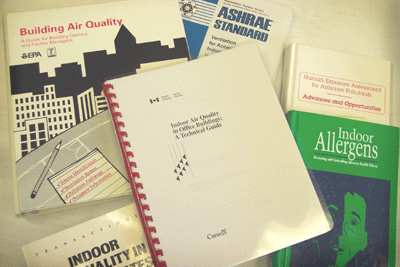








What
causes people today to worry about their environment
and personal air quality exposure?
•
People
are better informed today. News media constantly address and expose environmental
health concerns, technical literature in layman's terms is readily available,
and the Internet has empowered every person to search for expert opinion.
•
People are more sensitive today. Our cleaner environment and
absence of traditional disease has made people less resistant to infection.
We have moved toward a more hygienic lifestyle for very good reasons -
because it prevents the transmission of dangerous life-threatening
organisms.
But the cost of that may have been that we have deprived our immune response
of an essential stimuli during the first five years of life (National Post 1999).
How do people vaccinate themselves again? Development of allergic disease is
illustrated schematically. A genetically susceptible individual is exposed
to an allergen and becomes immunologically sensitized. At this stage the
person is asymptomatic, but the sensitization may be detected by skin tests
or laboratory tests. Over time, a proportion of sensitized individuals will
develop one of a group of allergic diseases. Exposure to an allergen is understood
to be a major factor at each stage of the pathogenesis of these diseases.
The most common allergic diseases caused by indoor allergens are allergic
rhinitis, sinusitis, asthma, and allergic skin diseases (dermatitis)
(National Academy of Sciences).
Lab
-VOC Analytical
Method
-Chain of Custody

OSB
Services/OSB Lab
2759 Thamesgate
Dr.
Mississauga, Ontario
Canada L4T 1G5
Phone: 905 677 0022
Fax: 905 677 0029
osblab@osbservices.com
osb@osbservices.com
Created by Aga


|
• People are less tolerant today. Expectations are high today supported by long life expectancy and advances in medicine. There are many individual and collective influences on building occupants affecting their well being, comfort and tolerance at work. Perception of the work environment is influenced by environmental stressors such as lighting, noise, vibration, overcrowding, ergonomics, interior design and psycho-social issues such as company organization, culture, job satisfaction, security, health and family related problems (PM Magazine 1995). |

|
The interaction of many environmental
components can lead to indoor air quality complaints. Many of these
environmental factors actually have little if anything to do with the
quality of air around us. If people feel ill, uncomfortable, or "out of
temperature", they blame air quality which also incorporates all aspects
of the air delivery system. Our specialty is the measurement of both the
chemical and people parameters that define indoor air quality (IAQ).
|
